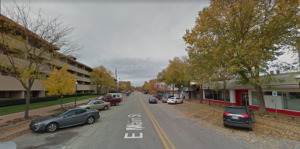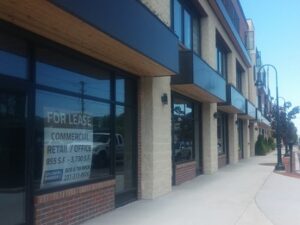A common frustration of communities who want to support affordable housing development is that the financing tools available to developers can be very all-or-nothing. The biggest source of funding for these developments, Low-Income Housing Tax Credits (LIHTC), is structured in a way that makes large, uniform apartment buildings the standard, creating a challenge for communities trying to fit affordable housing into a traditional Main Street context or hoping to create income diversity.

Main Street is a great place to include senior housing for access, but it requires Main Street design, not the standoffish setback seen here.
A panel at last week’s Building Michigan Communities conference offered some notes on how local communities can encourage mixed-use or mixed-income developments, breaking out of the “all-or-nothing” baseline for LIHTC-funded projects. As with any development, the message for communities that want to see mixed-income, mixed-use projects comes down to getting the local incentives and regulations working in the right direction-but the rules around federal affordable housing funds make these issues more acute:
Mixed-income or mixed use needs a mix of incentives
Most affordable housing relies on LIHTC as equity for construction, in most Michigan communities “market-rate” rents are not far enough above “affordable” rents for the increased cash flow of the market-rate housing to cover construction costs. Mixed-use construction presents more hurdles, requiring separate financing for the commercial component.
Communities that want mixed-income residential development need to work with developers (and MEDC) to create funding strategies that support market-rate residential or commercial portions of the development in parallel with LIHTC support for the affordable portion. This could include tools like brownfield TIF, obsolete property rehab abatements, or state CRP funding for the un-subsidized portion of the development. Even with a good incentive mix, distinguishing financing and allocation of construction costs for the affordable housing component may require separated ownership via a condominium arrangement.

The co-developer of this mixed-use, mixed-income development in Grand Rapids noted that the financing and cost-allocation requirements attached to LIHTC resulted in the 100 subsidized affordable apartments and 65 market-rate apartments being physically separated between wings of the building, rather than mixed in a more fine-grained way.
Push for AMI averaging to mix affordability levels
Traditional LIHTC development requires all funded housing be restricted to households making under 60% of the area median income (AMI), which leads developers to target a narrow band of incomes just under that cutoff. Under new Federal rules a LIHTC development can mix income level designations, including housing for residents making up to 80% of AMI, as long as the average is still below the 60% AMI threshold.
This means a housing development could mix 80% AMI apartments and 30% AMI apartments to serve both “middle income” households that earn too much to qualify under the traditional threshold, but still can’t afford market-rate rents, as well as households with very low incomes, covering a much broader swath of the community than an all-60% development.
While the panelists noted MSHDA has not yet formally implemented this new option in Michigan, communities that desire mixed-income affordable housing should ask developers (and MSHDA) to pursue this option-and bringing housing market data to the table demonstrating needs at various levels can help this ask.
Fine-tune zoning to enable mixed-use-but not require too much
Beyond financing, the panelists noted zoning as the biggest obstacle to creating developments that mix affordable housing with retail or other commercial space.

Market-rate apartments can carry mandated retail through a slow lease-up period, but if the upper stories are affordable housing, project financing requires the retail to provide its own cash flow quickly.
On the one hand, communities often have zoning ordinances that prohibit one use or the other, even when they’ve stated an interest in mixed-use development. On the other, zoning ordinances may require more commercial space than the developer can fill ‘with no expectation of cash flow from commercial rents, the project can’t get construction financing. (In hot residential markets, developers may be able to bring in enough rent for market-rate apartments to subsidize the unfilled commercial space, but the separated financing requirement for affordable housing prohibits this work-around.)
Finding the “goldilocks” point between not enough and too much mixed-use in the zoning ordinance will vary widely, likely even from block to block within a small downtown. Communities can give mixed-use that includes affordable housing the best shot, though, by making sure the zoning permits mixed-use, but backing off from requirements that 100% of ground-floor space be dedicated to non-residential uses.
Instead, consider focusing any hard requirement of commercial or other “active” use on the place where it makes the most difference: along the primary street frontage, or at the street intersection corner of the project, and only require that the nearest 20-30 feet of the ground floor to that frontage be commercial, allowing the developer to allocate the rest of the ground floor to either commercial or residential use, depending on their market study.